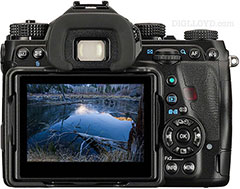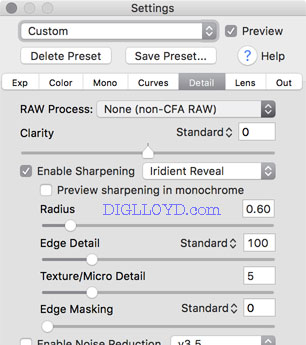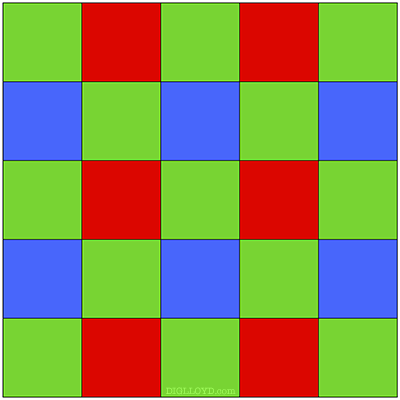Pentax K1 Super Resolution Pixel Shift Mode
See my Pentax K1 wish list at B&H Photo.
See also my review of the Pentax K3 and various Pentax DA HD Limited lenses and yesterday’s discussion of the Pentax K1.

Like the Pentax K3 II, the Pentax K1 pixel Super Resolution mode delivers full RGB color per pixel, in one huge DNG or PEF file.
The K-1 uses the latest super-resolution technology, which captures four images of the same scene by shifting the image sensor by a single pixel for each image, and then synthesizes them into a single composite image.
According to the Pentax K1 specifications, the K1 uses “Electronic shutter when using Pixel Shift Resolution”. It’s unclear if the EFC shutter is accessible in regular Live View exposures.
The Pentax Super Resolution feature differs from the approach of the 8-way oversampling of the Olympus OM-D E-M5 Mark II in three key ways:
- Pentax does four whole-pixel shifts with the goal of obtaining full RGB color at each pixel. The Olympus E-M5 Mark II approach uses 8 frames with half-pixel shifts and merges those frames in-camera into one higher resolution raw file, with the goal of higher resolution and reduced noise and full RGB color. The Olympus suffers from impaired micro contrast per pixel albeit at higher resolution; the Pentax has outstanding micro contrast (at least with the K3 II).
- The Pentax Super Resolution makes correction of motion artifacts possible (since any single frame of the four frames embedded inside the DNG could be used separately, including localized corrections). The in-camera merging of the Olympus approach results in extremely ugly motion artifacts.
- Pentax embeds all four exposures into a single DNG or PEF raw file. The Pentax approach in theory holds great promise for highly optimized raw conversion, including smart suppression of subject movement, optimized noise reduction, etc.

for Pentax K3 II SuperRes raw
In theory the K1 Super Resolution mode offers the most potent advance in image quality in years: full “true color” RGB pixels. And so it is a compelling reason for me to review it, even with the sharp dropoff of interest in DSLR cameras. Properly implemented, the Pentax 36MP sensor used in Super Resolution mode should trounce the Nikon D810 and the Sony A7R II in image detail and noise (see Sony A7R II: Where is Pixel Shift?). However, one practical challenge is the selection of high-grade lenses.
Conventional sensors are monochrome (RGGB Bayer matrix typically), recording a single 12 to 14 bit value per pixel. The Pentax K1 Super resolution mode promises the first true-color full-frame sensor on the market, with reduced noise behavior as a bonus.
The existing and rather inexpensive Pentax K3 IIalready has a Super Resolution pixel shift mode, which is supported by Adobe Camera Raw as well as Iridient Developer. Observe at right how Iridient Developer shows it as . CFA = Color Filter Array. In other words, it is true color for every pixel. However, Iridient Developer produces output that clear makes use of only one of the exposures, whereas ACR produces bitingly sharp ultra-fine detail, clearly using all the exposures.
The term “Super Resolution” is a bit confusing because resolution is generally taken as spatial resolution (detail) and yet the approach seems to be about color discrimination at each pixel. However, true color at each pixel in effect increases spatial resolution because no demosaicing interpolation should be needed; each pixel stands on its own.
True color per pixel is of minimal value for black and white test charts, but of major value in strongly monochromatic images dominated by shades of red or blue (a conventional sensor has only 1/4 red and 1/4 blue pixels).
Shifting the sensor for true color
I called Ricoh USA for confirmation, but apparently only Ricoh Japan has the answer and has not communicated the details. The Pentax K1 is assumed here to behave like its APS-C K3 II sibling.
The K1 shifts the sensor so as to record independent R/G/B values at each pixel, an approach used in certain Hasselblad medium format cameras. This “pixel shift” approach requires 4 exposures in total, and thus can be problematic for moving subject matter: grass and leaves in wind, moving water, or anything moving at slower shutter speeds. But if the subject matter and camera are unmoving, it offers an ideal solution to the issues of a Bayer matrix sensor. Moreover the K1 appears to be really smart about detecting movement and avoiding combining pixels in areas of movement. At the least, the storing of all four exposures means that any single exposure could be used, assuming the raw converter supports that.

Two green samples at each location are acquired, which in theory should cut certain types of noise by √2 for the green channel (twice the exposure), assuming appropriate handling by the raw converter.
The Pentax Super Resolution mode means four 14-bit values per pixel: 14 bits for red, 14 bits for green (twice), 14 bits for blue AKA 42-bit color.
Examining the Bayer matrix grid, the four shifts for full RGB color would need to be {unshifted, shift left, shift down, shift diagonal} thus yielding four 14-bit color samples at each grid location: RGGB for every pixel. All four exposures are saved into a single DNG file.
Four samples per pixel implies higher resolution for fine detail as well as higher dynamic range via reduced noise [2X the light capture for G value]. All of this potential has to be proven out, which is why I want to review the K1, but Super Resolution files from the Pentax K3 II look outstanding.
See also the Pentax File format and Size.
Roy P writes:
Yes, I’ve been tracking the Pentax. Re your comment, “Properly implemented, the Pentax 36MP sensor used in Super Resolution mode should trounce the Nikon D810 and the Sony A7R II in image detail and noise”, I expect Sony to also come out with an A7R-III that has pixel shifting, and that will likely followed by Nikon and Canon as well.
But that’s not all – I think this kills medium format. I just don’t see PhaseOne + Schneider lenses beating a K-2 or A7R-III + Otus or even other Zeiss lenses. Maybe PhaseOne survives, if they implemented pixel shifting / oversampling.
But the company that’s really likely to find itself looking horribly obsolete is Leica. All flagship Leica cameras in the S, the SL and the M lines already look very outdated, and Leica just doesn’t seem to be with it.
Can the Pentax cameras work with Nikon F-mount or Leica R lenses?
DIGLLOYD: I’m wondering what is holding Sony back on doing a Super Resolution mode. Patents could be the issue but my understanding is that Sony has a controlling interest in Olympus, so that doesn’t seem right. But Canon and Nikon are dragging their feet on any advances... first they’d have to implement in-body stabilization and then support pixel shift. This does not seem likely to me, but we can hope.
I agree that medium format may suffer from this new technology, particularly if we see pixel shift at 42 or 50 megapixels (also the Pentax 645Z with pixel shift would be stunning, good as it is already!). Pixel shift will absolutely have on effect on most medium format systems (product shots and such are a mainstay), and I doubt the new PhaseOne 100 megapixel would be able to compete—the lenses just aren’t good enough for starters. Lots of pixels with crummy micro contrast is not a real gain. On the other hand, the use of medium format is often for very specific job-based reasons—see for example Ming Thein’s switch to Hasselblad.
Leica cameras are a niche unto themselves, and there are usability pluses and minuses, but I agree—I can’t see the point of shooting conventional 24 megapixels or 36—the game is changing very fast, with Pentax in the DSLR vanguard. But that’s NOT what drives Leica buyers, so this game has a lot of innings left to play.
Lenses: see Pentax K1 Full Frame Lens Selection.





























